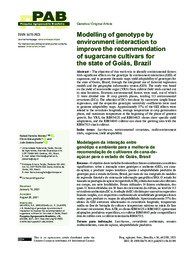Modelling of genotype by environment interaction to improve the recommendation of sugarcane cultivars for the state of Goiás, Brazil.
Modelling of genotype by environment interaction to improve the recommendation of sugarcane cultivars for the state of Goiás, Brazil.
Author(s): MONTES, R. F.; BRESEGHELLO, F.; DUARTE, J. B.
Summary: The objective of this work was to identify environmental factors with significant effects on the genotype by environment interaction (GEI) of sugarcane, and to generate thematic maps yield adaptability of genotypes for the state of Goiás, Brazil, through the integrated use of factorial regression models and the geographic information system (GIS). The study was based on the yield of recoverable sugar (YRS) from cultivar field trials carried out in nine locations. Fourteen environmental factors were used, out of which 11 were divided into 10 crop growth phases, totaling 113 environmental covariates (ECs). The selection of ECs was done by successive simple linear regressions, and the respective genotypic sensitivity coefficients were used to generate adaptability maps. Approximately 57% of the GEI effects were related to the covariates longitude, average temperature at crop germination phase, and maximum temperature at the beginning of the phase of greatest growth. For YRS, the RB034128 and RB034021 clones show specific yield adaptations, and the RB034045 cultivar can share the growing area with the RB867515 check cultivar.
Publication year: 2021
Types of publication: Journal article
Unit: Embrapa Rice & Beans
Observation
Some of Embrapa's publications are published as ePub files. To read them, use or download one of the following free software options to your computer or mobile device. Android: Google Play Books; IOS: iBooks; Windows and Linux: Calibre.
Access other publications
Access the Agricultural Research Database (BDPA) to consult Embrapa's full library collection and records.
Visit Embrapa Bookstore to purchase books and other publications sold by Embrapa.

